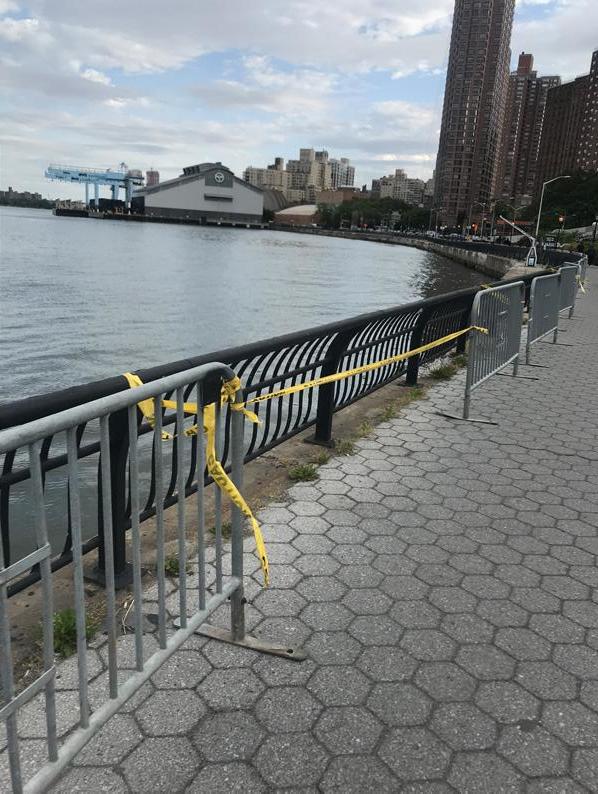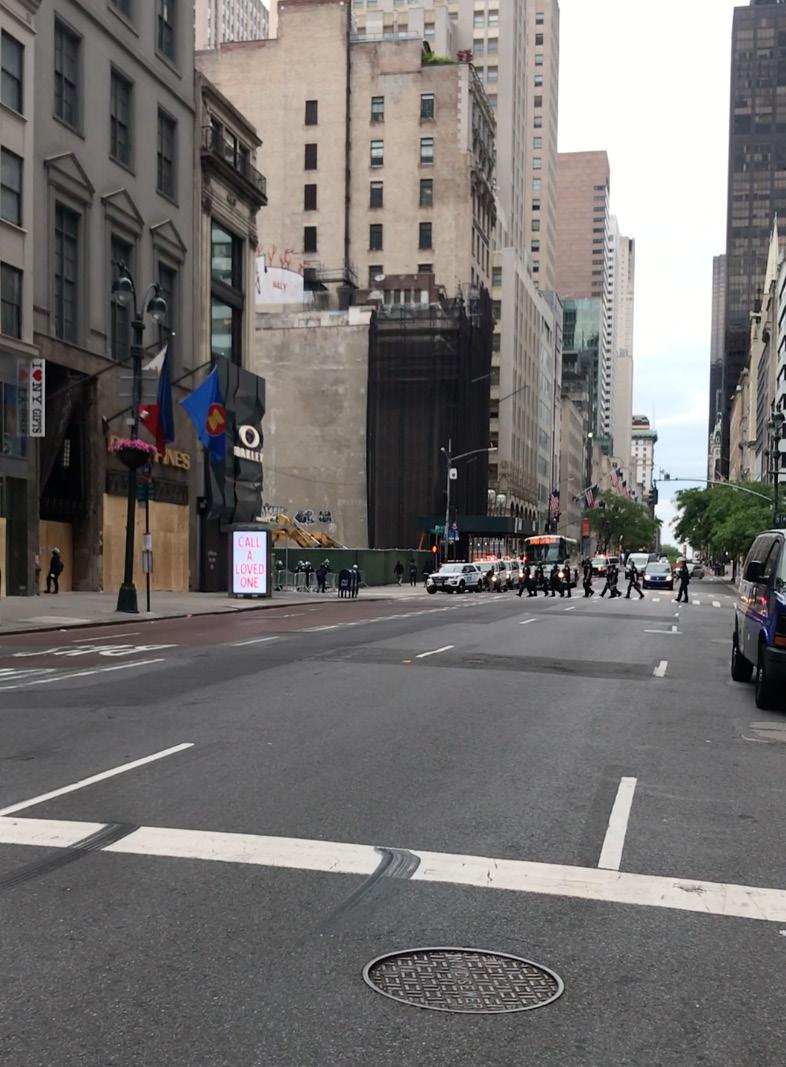
10 minute read
Concerning the Events of June 2, 2020 Hayes Buchanan
Concerning the Events of June 2nd, 2020
Hayes Buchanan M.S. UP
Advertisement
The murder of George Floyd at the hands of Minneapolis police officers sparked protests that dominated the summer of 2020. Since then, there has been much written about the injustice of our criminal justice system, the metastasis on city budgets and citizen sanity perpetrated by policing agencies, and the violence that the society we inherited inflicts on people of color and the poor. I hope that this personal narrative, anecdotal in nature, can be a modest compliment to these bodies of work. As a frequent attendee of the New York City protests this past summer, I hoped to document my experience for personal posterity as 2020 drew to a close. My submission to Urban Magazine was the impetus I needed to finally put pen to paper. The following documents a vignette of a night less than a week after the unrest began. I do not believe that this discourse is zero sum, that the presence of my voice in this magazine drowns out that of countless, more deserving others. That being said, it is understandable if the reader is not interested in reading a white man’s perspective. I write using the only perspective I have. become ubiquitous as the summer went on. By 8 pm, the sun was beginning to set and I split from the group when we got to Union Square. Just as the Mayor’s curfew was coming into effect, I ran into a smaller group nearby that was in a confrontation with police. The protestors stood their ground and eventually the police retreated to their vehicles and drove away, to much celebration. One protestor carried an upside down American flag. Another, brandishing a lighter, asked if he could burn it. Just as the police left the scene a large group made its way to Union Square, merging with the smaller one I was a part of. This group had several leaders, who I only classify as such because they carried bullhorns, although I would soon learn that to the extent the early protests were organized at all it was ad hoc and these leaders were self-appointed. The self-proclaimed leaders disagreed on which way to take the large crowd and encouraged us to take a knee while a decision was made. During this lull in the noise, the sound of glass shattering split the air. The consternation about looters had already begun in the media, but this was the first time I encountered them. The men with bullhorns lambasted the looters and quickly realized their error in stopping the march. The looters didn’t seem to care. We marched south as dusk settled in.
Around 6 pm on the evening of Tuesday, June 2, I left my apartment and headed to a protest that was taking place on the Upper East Side at Gracie Mansion. Finding the East River Path blocked, I deviated to city streets, in search of a group of protestors in Midtown. Around 7 pm, I joined a group marching along Park Ave, my tongue tepidly shaping the names of George Floyd and Breonna Taylor in chants that would My memory of the events starts to get a bit hazy after nightfall. I’ll admit that I am a terrible estimator of headcount, but if I were to guess, it felt like there were over a thousand of us in our group, which stretched back in an immeasurable tail. I remember being in the West Village and then Soho. Turning left onto Canal Street in Tribeca. The ad hoc organizing became increasingly more organized - particularly among the minority of cyclists in the pack. As cyclists, we played a unique role,
scouting ahead for police presence, directing foot traffic with flashlights when the group would turn, and blocking cross traffic, although we encountered few drivers after the curfew. I remember when a cyclist from another protest rode up and told the de facto leaders of our group that their group was heading for the World Trade Center. I accompanied him back to his group to try and arrange a merger between us. Riding between the two crowds took us through a surreal, empty, and starkly quiet city. In some places, we weaved among makeshift barricades of trash that protestors had erected in the wake of their march. Going from the clamor of the crowd to the empty canyons of Soho, its storefronts hardened with plywood, was disorienting. I remember looters breaking the window of a liquor store in Tribeca. The typical cyclist response to this eventuality was to put our bikes in front of the broken storefront and chant, “keep moving!”, until the crowd had passed, but there was little we could do. The looters were just teenagers and they seemed to be doing it for kicks. As the night went on and protestors trickled into the subway system, the looters seemed to stick around and the proportion of looters to protestors grew. The police became more aggressive too -- staying in their vehicles and keeping their distance but occasionally rolling up on the march with lights on in a column. Around midnight, the group was marching around City Hall Park when I noticed a small contingent of protesters leaving down a side street. I recognized one of them as the bullhorntoting protestors who gave me good vibes. I felt like it was time to go, so I followed them. We got to talking and introductions when suddenly a column of police vehicles streamed around a corner. Half of us got away but the rest of us got caught standing stupidly on the sidewalk. When the police officers confronted us, we weren’t read our Miranda rights. My bike was taken away from me. While being zip tied, a white shirt (shorthand for a senior or commanding officer) congratulated the officers on their “nice work.” This was confusing. Hadn’t they let half of us escape and only apprehended those of us that didn’t run? The seven or eight arrestees were lined up and patted down. None of us were violent. One man who was with us must have been 7’ tall and I could tell the police were afraid he would try to resist, but he didn’t. One officer asked what was in my backpack. Before I could answer, he dumped it upside down onto the pavement, shattering my phone screen. Its other contents were a light jacket and a water bottle, which was untouched for most of the night. I was already thirsty. We lined up to board the paddywagon. On the way in, an officer relished the opportunity to tighten each of our restraints, sharpening the pain in my wrists. Once in motion, we continued introducing ourselves in an attempt to make light of the shitty situation. We were taken to a booking facility on Schermerhorn Street in Brooklyn (the Manhattan booking facility was apparently full) and found ourselves in a line stretching out the door and around an enclosed but open-air parking area. It must have been past midnight when we arrived and having spent the previous 5 hours riding my bike, the next few hours of standing elongated before me. The dehydration and pain in my wrists started to overwhelm me as time passed. Afraid I would faint, I crouched against the bricks, unable to break my fall with anything else. I remember another protester I’d
6:21 PM 6:45 PM 7:01 PM
8:01 PM 8:04 PM


Heading to a protest at Gracie Mansion I am turned away by two officers on the east river bike path. I decide to go to midtown and see if I can find another. Searching for a protest I find several fleets of NYPD vehicles that appear to be staging for some kind of intervention Park Ave.


Moments after a small group of protestors face down several police officers. Passing the boarded up windows of downtown retailers. 8:10 PM

Moments after the looting started.
been arrested with, a nonbinary person who I’d later learn studied landscape architecture, kissing my shoulder in comfort. My vision was cloudy. We asked for water many times, and were told there was none. I thought of the full water bottle in my backpack. As the line progressed and got longer behind us, we realized we had been treated comparatively well. Protestors arrived with swollen eyes, covered in bruises. It was easy to recognize how the white prisoners were being treated with less violence and more sympathy than the others. Of the arrestees in this staging area, about half had light skin. We kept asking for water and eventually our arresting officer, P.O. Rueda, allowed us to sip from the water bottle from my bag. At the same time, a Black protester my age was vociferously asking for the same of his officer: “We see guys like this all the time,” Rueda explained in undertone. “They just do this for the attention. Give him water, and the next thing you know, he’ll be asking for food. It never stops.” After a few hours we made it inside the building. Our restraints were removed (the relief!) and we were put into holding cells divided by male and female gender identities. It goes without saying that there was not adequate room for social distancing but I had already concluded that I’d be infected with COVID-19 by the end of the night, and felt no trepidation on the subject. We were searched again. The drawstrings on my pants were cut and my shoelaces removed. I learned Rueda was Colombian and that he had a graduate degree. He referred to the week’s events as “the Purge.” The rest of the night amounted to waiting in line, being put in a cell, waiting in line, and then being put in another cell. The police called us “bodies” or “collars.” Their badge numbers were obscured by the Thin Blue Line (a motif used by police officers to show their distinctness from the communities they serve. During the protests they would obscure their badge numbers ostensibly to pay homage to officers that died of COVID-19, but the practice had the effect of limiting officer accountability by preventing their identification by badge number). Mask use was infrequent. The hallways were narrow and stained, and a riot helmet and club bounced at the hip of each officer. To open a cell at the end of the long hallway where we queued an officer would have to shout down the line for someone at the front desk to unlock it. This happened constantly. Out of sight, a man had his own cell. He was talking to himself, screaming, rattling the bars of his cage. It was difficult to hear anything else. Despite the noise, I tried to sleep in the final cell of the night, this one with benches lining the walls. I knew the subway was closed, as were the Brooklyn, Manhattan and Williamsburg bridges. I prepared myself for the long walk to West Harlem. Finally, Rueda arrived to let me out. We had developed a custom of clapping and cheering when one of us was let out and my release was not an exception. At the exit, I was given my summons and my backpack. I walked out alongside my new friend (they had been placed in the female-identifying cell despite their gender ID) who was released at the same time. A smartly dressed detective with a friendly demeanor stopped us and asked us some questions about who organized the protest. She seemed to be trying to figure out if we were “antifa.” We told her we didn’t know and trudged to the sidewalk. Around the corner we found a group of people with water bottles, snacks, and phone chargers. Jail support. They gave us a ride home.
Hayes is a second year planning student and co-founder of the student organization GreenSAPP.










